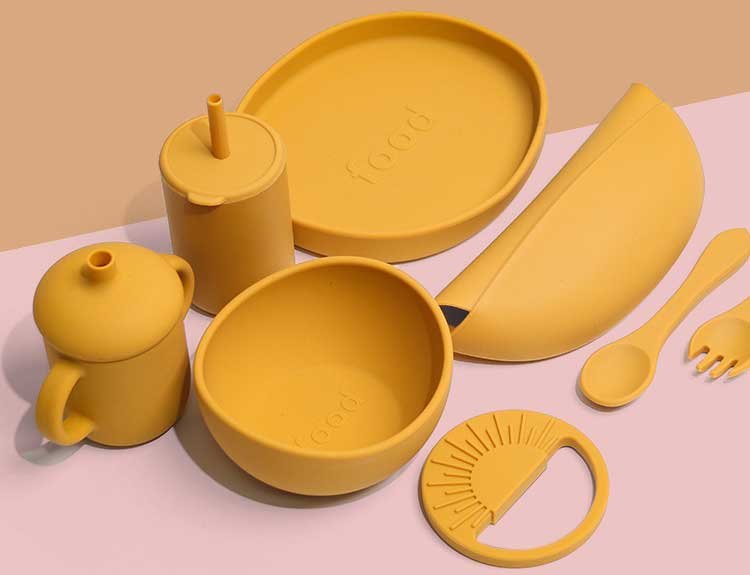Many parents feel overwhelmed when starting solids—choosing the right tools can make a big difference.
Using silicone products during solid food transition helps ensure safety, hygiene, and ease of use. They’re durable, non-toxic, and baby-friendly, making the journey smoother for both parents and infants.
Parents want peace of mind when feeding their babies. I’ve seen how the right silicone tools can reduce stress and make mealtime more enjoyable. Let’s break it down step-by-step.
Why choose silicone for baby feeding?
Some feeding products contain harmful chemicals or break easily. That creates risks for babies and stress for parents.
Silicone is non-toxic, durable, and easy to clean. It’s free of BPA, phthalates, and other harmful chemicals. That makes it one of the safest choices for feeding babies.

When I started looking into feeding tools for my child, I wanted something safe and long-lasting. Silicone stood out right away. It’s used in medical and food-grade products because it doesn’t leach chemicals even when heated. For babies who are learning to chew, bite, and grab, silicone provides a soft texture that won’t hurt their gums.
Let’s compare silicone to other materials:
| Material | Safety Level | Durability | Ease of Cleaning | Baby-Friendly Texture |
|---|---|---|---|---|
| Plastic | Low | Medium | High | Hard, sometimes brittle |
| Glass | High | Fragile | High | Too hard for babies |
| Stainless Steel | High | High | Medium | Too rigid for soft gums |
| Silicone | High | High | Very High | Soft, flexible |
What makes silicone special is how it adapts to a baby’s needs at every stage. From soft spoons to suction plates, it creates an easy-to-manage system for parents. No sharp edges, no worrying about breakage.
What silicone tools do you need for starting solids?
Too many feeding items clutter the kitchen and confuse first-time parents.
Start with essential silicone tools: suction plates, soft-tipped spoons, bibs, and cups. They simplify feeding and minimize messes.

When transitioning from milk to solid food, babies aren’t just learning to eat—they’re learning to sit, hold utensils, and explore textures. That means the tools need to support development, not just serve food.
Here are the basics I recommend:
- Silicone Suction Plate: Keeps food in place and reduces tipping. Divided sections help you introduce variety without overwhelming your baby.
- Silicone Spoon: A soft-tip protects sensitive gums. The ergonomic handle supports grip development.
- Silicone Bib with Pocket: Catches spills and food, keeping clothes cleaner.
- Silicone Training Cup: Helps babies transition from bottles to open cups safely.
These tools are easy to sterilize and dishwasher safe. I also liked that they come in fun colors, which made feeding more engaging. And since silicone is odor-resistant, it doesn’t carry over food smells or stains.
How do you introduce solid food using silicone tools?
Parents often struggle with messy meals and baby resistance in the early days of solids.
Use silicone spoons for first tastes, suction plates for finger foods, and training cups for water. Stick to a routine and let your baby explore.
The key is to go slow and stay consistent. I started with one silicone spoon and one meal a day. My baby was curious but hesitant at first. I learned that the soft texture of the spoon made it easier for her to accept new flavors.
Here’s a rough timeline you can follow:
| Age | Silicone Tool to Use | Food Type | Tips |
|---|---|---|---|
| 6 months | Soft spoon, suction bowl | Purees (banana, avocado) | Offer 1-2 teaspoons |
| 7–8 months | Suction plate, silicone bib | Mashed soft solids | Add texture gradually |
| 9–10 months | Training cup, self-feeding tools | Finger foods | Encourage self-feeding |
Routine matters. I kept mealtimes at the same time each day and let my baby explore. Silicone tools were light and easy for small hands to grab. The bib caught the mess so I wasn’t cleaning food off the floor constantly. That made the experience less stressful.
How do you clean and maintain silicone feeding tools?
Dirty or damaged tools can lead to hygiene issues and health risks for babies.
Wash silicone tools with mild soap or put them in the dishwasher. They resist stains and dry quickly, making cleanup simple and safe.

After each meal, I just tossed the bib and spoon into the dishwasher. No scrubbing. No weird smells. Silicone dries fast and doesn’t absorb food residue. That’s important because leftover food particles can grow bacteria.
For a deeper clean once a week, I boiled the tools for 2–3 minutes. Silicone can handle high heat without deforming. I also inspected spoons and plates regularly for signs of wear. If any product looked scratched or torn, I replaced it right away.
Cleaning checklist:
- ✅ Rinse immediately after use
- ✅ Wash with mild dish soap or run in the dishwasher
- ✅ Air-dry or towel-dry quickly
- ✅ Boil weekly for sterilization
- ✅ Store in a clean, dry drawer
This habit kept everything safe and ready for the next meal. And it saved me a lot of time during busy mornings.
Conclusion
Silicone tools make solid food transition safer, easier, and more enjoyable—for both babies and parents.